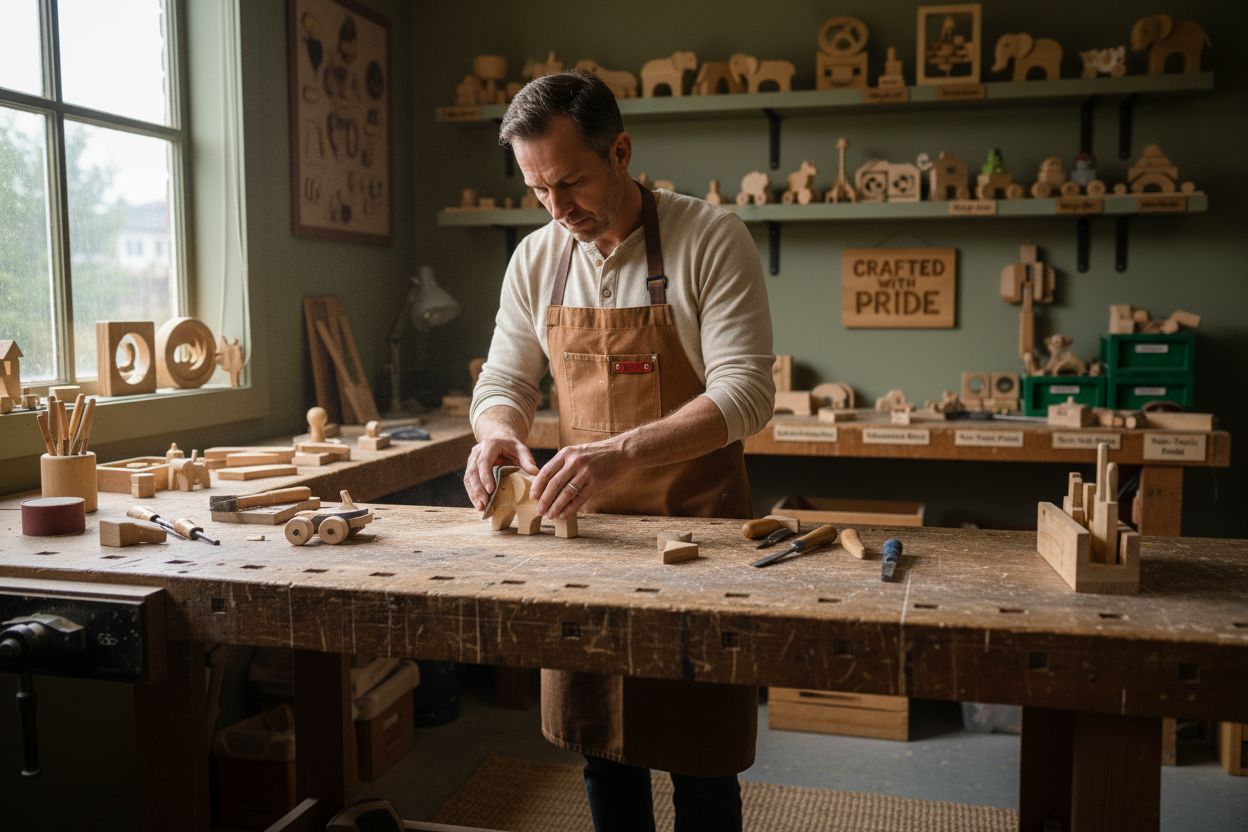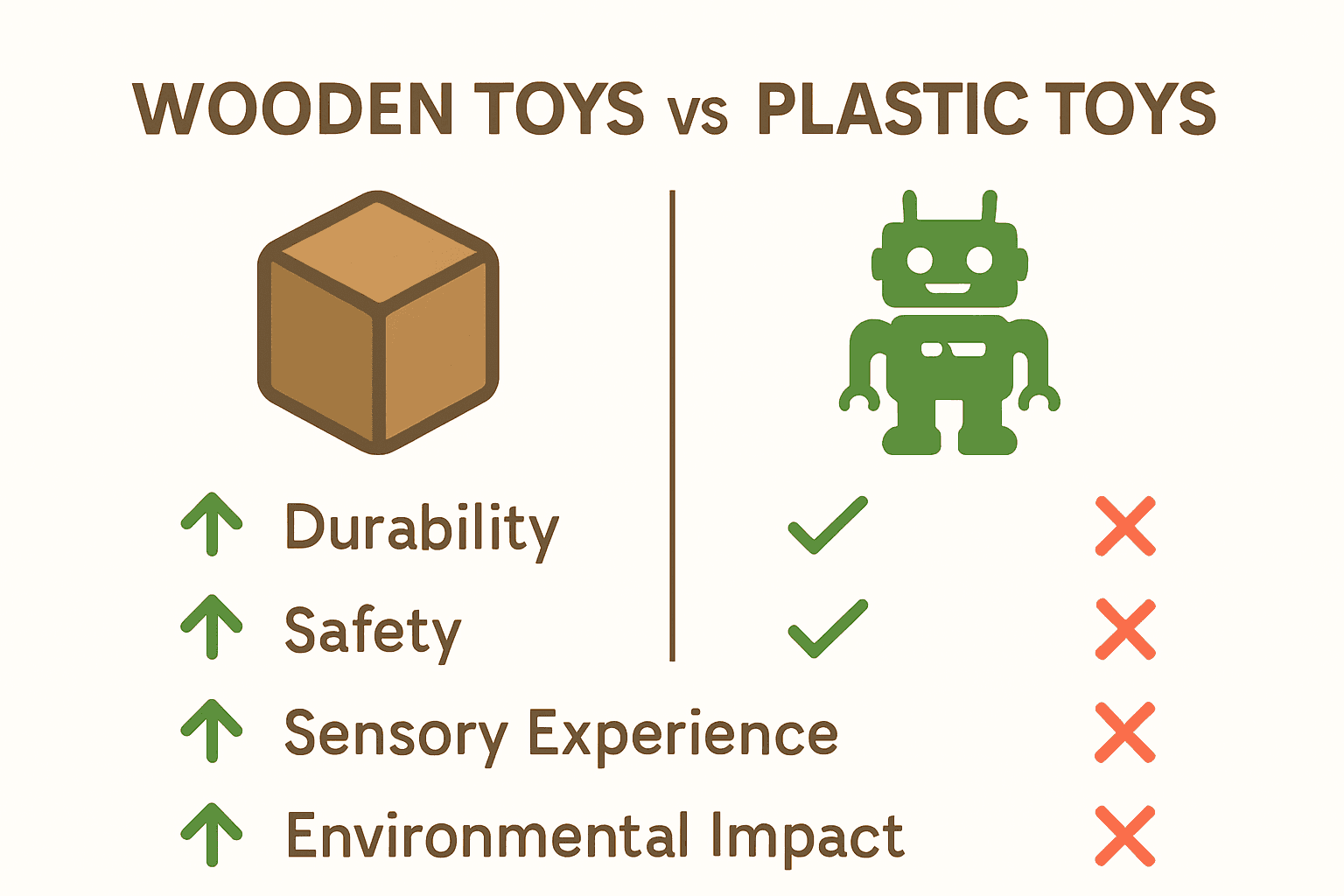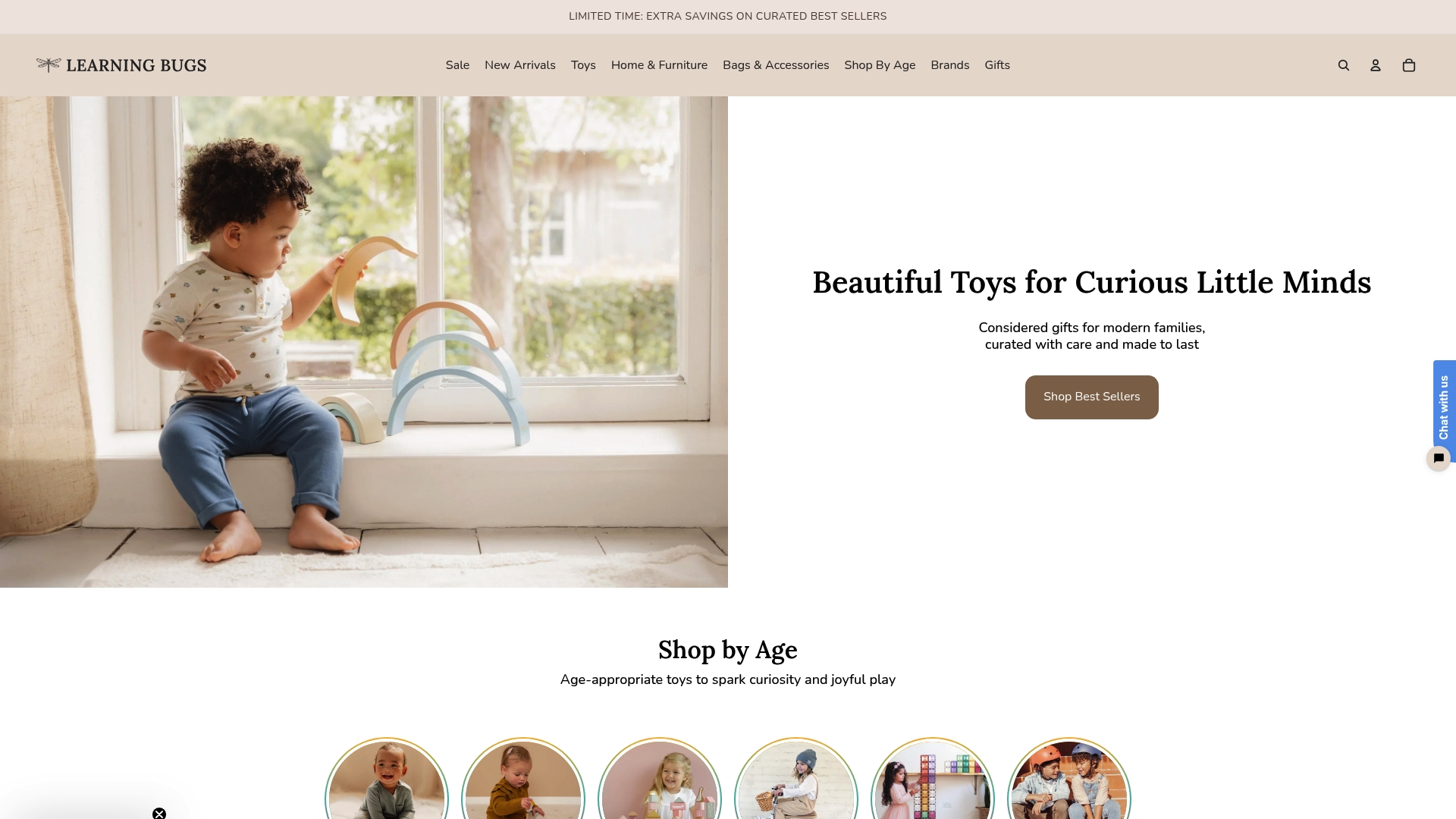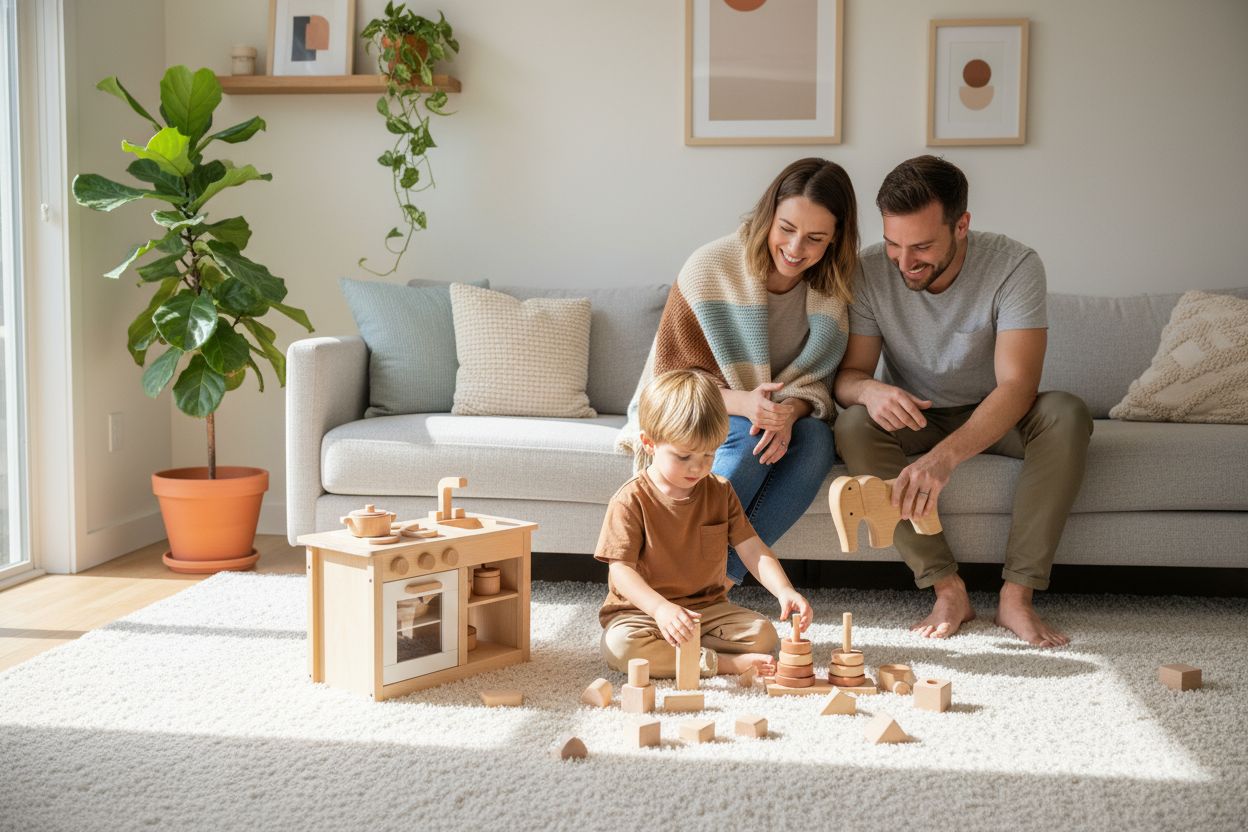Did you know that over 70 percent of parents now actively seek non-plastic play options for their children? Wooden toys have made a strong comeback in family homes, challenging the idea that only high-tech or brightly colored plastic toys can inspire young minds. These classic playthings offer children a richer, more natural way to explore, create, and learn while providing lasting value that goes far beyond their nostalgic charm.
Key Takeaways
| Point | Details |
|---|---|
| Developmental Benefits | Wooden toys promote cognitive, sensory, and motor skill development, making them superior choices for holistic growth. |
| Safety and Sustainability | Unlike plastic toys, wooden toys are often non-toxic, durable, and made from renewable resources, providing a safer and more eco-friendly option. |
| Variety and Adaptability | Today’s wooden toys include diverse categories, from educational tools to imaginative playsets, which adapt to children’s evolving interests. |
| Quality Selection | When choosing wooden toys, prioritize craftsmanship, safety standards, and the use of sustainably sourced materials to ensure long-lasting value. |
Table of Contents
- Wooden Toys: Definition And Common Misconceptions
- Types Of Wooden Toys And Core Variations
- Developmental And Sensory Benefits For Children
- Safety, Sustainability, And Eco Credentials
- Wooden Vs Plastic Toys: Key Differences
- Choosing Quality Wooden Toys In The UK
Wooden Toys: Definition and Common Misconceptions
When we talk about wooden toys, we’re referring to playthings crafted primarily from natural wood materials, designed to engage children through tactile, sensory, and imaginative play experiences. Unlike plastic alternatives, wooden toys represent a timeless approach to childhood entertainment that connects children with natural materials and traditional craftsmanship.
Common misconceptions about wooden toys often prevent parents from exploring these remarkable play tools. Many believe wooden toys are boring, fragile, or exclusively traditional. However, modern wooden toys are anything but outdated. They are sophisticated, beautifully designed learning instruments that offer multiple developmental benefits.
 Read our guide on open-ended toys to understand how versatile these playthings can be.
Read our guide on open-ended toys to understand how versatile these playthings can be.
Wooden toys come in numerous varieties, challenging the stereotype that they’re limited to simple blocks or basic puzzles. Today’s wooden toy collections include:
- Complex building sets
- Intricate role-play collections
- Scientific and mathematical learning tools
- Musical instruments
- Sensory exploration kits
What makes wooden toys truly special is their ability to grow with a child. Unlike electronic gadgets that quickly become obsolete, wooden toys adapt to different developmental stages, encouraging creativity, problem-solving, and imaginative thinking. They’re durable, environmentally friendly, and provide a screen-free alternative that stimulates genuine cognitive and motor skill development.
Types of Wooden Toys and Core Variations
Wooden toys encompass a wonderfully diverse world of play experiences, ranging from classic designs to innovative learning tools. The core variations in wooden toys can be categorised based on developmental stages, learning objectives, and play styles, offering parents a rich spectrum of options to support their child’s growth and imagination.
Learning and Cognitive Development Toys
In this category, wooden toys focus on critical developmental skills. Discover more about educational play approaches in our Montessori toys guide, which highlights how intentionally designed toys can support cognitive growth. These toys typically include:
- Puzzle sets with increasing complexity
- Mathematical manipulation blocks
- Shape sorters and matching games
- Counting and numerical learning tools
- Geometric construction sets
Imaginative and Role-Play Wooden Toys
Another significant variation involves toys that encourage dramatic play and social skill development. These include miniature wooden kitchens, tool sets, doctor kits, and transportation models that allow children to explore real-world scenarios through safe, engaging play. Such toys help children understand social interactions, develop empathy, and practice communication skills.
Beyond traditional categories, wooden toys also span sensory exploration tools, musical instruments, and open-ended construction sets. What makes these toys remarkable is their ability to adapt to a child’s evolving imagination, providing durable, sustainable play experiences that grow alongside the child’s developing skills and interests.
Developmental and Sensory Benefits for Children
Wooden toys play a pivotal role in supporting children’s holistic developmental journey, offering far more than simple entertainment. These thoughtfully crafted playthings serve as powerful tools for sensory exploration, cognitive growth, and skill enhancement across multiple developmental domains. Learn more about educational play strategies in our comprehensive guide, which reveals how intentional toy selection can dramatically impact child development.
Physical and Motor Skill Development
Wooden toys provide unique opportunities for developing fine and gross motor skills. The natural texture, weight, and design of these toys encourage children to:
- Manipulate objects with precision
- Develop hand-eye coordination
- Practice gripping and releasing
- Build muscle strength and control
- Enhance spatial awareness
Cognitive and Sensory Learning
The multisensory nature of wooden toys stimulates cognitive processing in extraordinary ways. Unlike plastic toys with predetermined outcomes, wooden toys invite open-ended exploration. Children learn through touching different textures, understanding weight distribution, and discovering cause-and-effect relationships by physically interacting with these natural play objects.
Moreover, wooden toys support neurological development by engaging multiple senses simultaneously. The subtle variations in wood grain, temperature, and weight provide rich sensory feedback that plastic alternatives cannot replicate. This sensory complexity helps children develop more nuanced perceptual skills, encouraging deeper learning and more imaginative play experiences that adapt and grow with their developmental stages.
Safety, Sustainability, and Eco Credentials
Wooden toys represent more than just playthings; they are a conscious choice for parents who prioritize safety, environmental responsibility, and long-term sustainability. Unlike mass-produced plastic alternatives, wooden toys offer a natural, non-toxic approach to childhood play that addresses growing concerns about material safety and ecological impact. Explore our insights on choosing sustainable play options, which highlight the importance of mindful toy selection.
Material Safety and Non-Toxic Considerations
Parents can feel confident about wooden toys’ safety profile. These toys typically feature:
- Non-toxic, water-based paint finishes
- Naturally antibacterial wood surfaces
- Splinter-free, carefully sanded construction
- Chemical-free manufacturing processes
- Durability that reduces replacement frequency
Environmental and Sustainability Credentials
Wooden toys excel in environmental credentials. Crafted from renewable resources like sustainably harvested timber, these toys represent a responsible alternative to petroleum-based plastic products. Their production generates significantly lower carbon emissions, and many wooden toys can be composted or biodegrade naturally at the end of their lifecycle.
Additionally, wooden toys transcend single-use consumption patterns. Their robust construction allows them to be passed down through generations, creating cherished family heirlooms that reduce waste and promote a more circular approach to children’s play. By choosing wooden toys, families make a tangible commitment to environmental stewardship, teaching children valuable lessons about sustainability through their everyday play experiences.
Wooden vs Plastic Toys: Key Differences
The choice between wooden and plastic toys represents more than just a material preference - it’s a fundamental decision about play quality, developmental impact, and environmental responsibility. While plastic toys dominate the market with their bright colours and low cost, wooden toys offer a substantially different play experience that prioritises sensory engagement, durability, and meaningful interaction. Discover more about choosing creative play options in our comprehensive guide, which explores the nuanced world of toy selection.
Sensory and Developmental Distinctions
Wooden toys fundamentally differ from plastic alternatives in their sensory characteristics:
- Natural temperature variation
- Unique textural experiences
- Weight and balance that mimics real-world objects
- Subtle acoustic properties when manipulated
- Organic visual aesthetics
Long-Term Value and Environmental Impact
Here’s a comparison of wooden toys and plastic toys:
| Aspect | Wooden Toys | Plastic Toys |
|---|---|---|
| Material | Natural wood | Synthetic plastic |
| Durability | Long-lasting Repairable |
Often short-lived Prone to breakage |
| Sensory Experience | Unique textures Natural weight Organic look |
Smooth Lightweight Bright colours |
| Safety | Non-toxic paint Splinter-free |
May contain chemicals Risk of small parts |
| Environmental Impact | Biodegradable Sustainable resources |
Non-biodegradable Polluting manufacturing |
| Developmental Value | Encourages open-ended play Stimulates imagination |
Predetermined uses Less creative engagement |
| Plastic toys typically represent a disposable consumer model, whereas wooden toys embody sustainability and generational value. Plastic toys often: |

- Degrade quickly
- Contain potentially harmful chemicals
- Create significant environmental waste
- Offer limited developmental stimulation
In contrast, wooden toys are crafted to endure, providing a lasting play experience that can be passed down through generations. Their construction emphasises quality over quantity, encouraging children to develop deeper, more meaningful relationships with their play objects. The inherent durability of wooden toys means they survive multiple play cycles, reducing consumption and teaching children valuable lessons about caring for and maintaining their treasured possessions.
Choosing Quality Wooden Toys in the UK
Selecting high-quality wooden toys requires more than just aesthetic appreciation - it demands a nuanced understanding of craftsmanship, safety standards, and developmental potential. Parents seeking exceptional wooden toys must navigate a landscape of varying quality, focusing on key indicators that separate exceptional playthings from ordinary objects. Explore our expert comparison of top creative toys to understand the intricate world of thoughtful toy selection.
Critical Quality Assessment Factors
When evaluating wooden toys, parents should pay attention to several crucial elements:
- Craftsmanship: Smooth edges, seamless construction
- Wood Source: Sustainably harvested timber
- Finish Quality: Non-toxic, water-based paints
- Age Appropriateness: Matching complexity to developmental stage
- Manufacturing Origin: Preferably UK or European artisan producers
Safety and Durability Considerations
Quality wooden toys distinguish themselves through meticulous construction and safety standards. Look for toys that demonstrate:
- Robust structural integrity
- Resistance to splintering
- Minimal use of chemical treatments
- Compliance with UK toy safety regulations
- Potential for intergenerational play
Beyond immediate visual appeal, superior wooden toys represent an investment in a child’s developmental journey. They offer more than momentary entertainment - they provide sensory-rich experiences that grow alongside a child’s cognitive and motor skills. By prioritising craftsmanship, safety, and educational potential, parents can select wooden toys that become cherished companions in their child’s learning and imagination.
Discover Wooden Toys That Grow With Your Family at Learning Bugs
Are you searching for toys that actually support your child’s development rather than just adding to the clutter? The article highlights how wooden toys offer lasting value, encourage open-ended play, and provide sensory-rich experiences unlike their plastic counterparts. Many parents worry about safety, durability, and finding toys that truly nurture creativity. At Learning Bugs, we understand these concerns and have carefully curated a collection that meets the highest standards for sustainability, craftsmanship, and joyful learning. Explore solutions that tackle these everyday challenges and inspire children to grow, imagine, and thrive.

Give your child the gift of meaningful play today. Visit our handpicked range of wooden toys and creative play products and see how our commitment to quality can make a difference. Discover a simpler, more inspired way to shop and enjoy the confidence of choosing toys designed for modern families. Browse Learning Bugs now and transform your child’s playtime with options that last. The best time to start their journey with natural, lasting toys is right now.
Frequently Asked Questions
What are the benefits of wooden toys for child development?
Wooden toys offer many developmental benefits, including enhanced fine and gross motor skills, cognitive growth through open-ended exploration, and improved sensory processing due to their natural textures and weight.
How do wooden toys compare to plastic toys in terms of safety and durability?
Wooden toys are typically safer as they often use non-toxic finishes and are naturally antibacterial. They are also more durable, lasting longer than many plastic toys, which can degrade quickly and may contain harmful chemicals.
What types of wooden toys are best for promoting imaginative play?
Toys like miniature kitchens, role-play sets, and open-ended construction toys are excellent for promoting imaginative play, allowing children to explore real-world scenarios and develop social skills through dramatic play.
How can parents assess the quality of wooden toys?
Parents should look for smooth edges, robust construction, sustainably sourced wood, non-toxic finishes, and compliance with safety regulations. Quality toys are often designed to endure multiple play cycles and engage children across various developmental stages.
Recommended
- News – Learning Bugs
- Essential Guide for First Birthday Toys: Top Picks for Joy – Learning Bugs
- Complete Guide to Open-Ended Toys for Children – Learning Bugs
- Top Creative Toys for Children – Expert Comparison 2025 – Learning Bugs
- Best Sustainable Baby Bottles: Comfort-First Guide | Family Bottle Fit
- Safe Sound Machines by Age: Newborn to Toddler Guide | Baby Sound Machines

0 comments